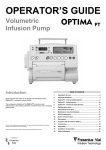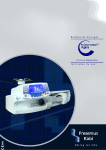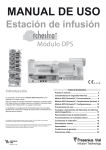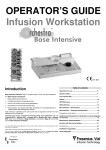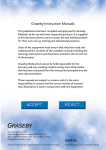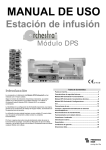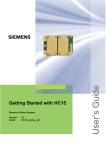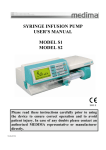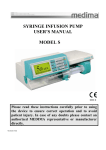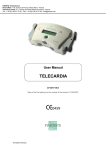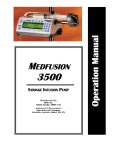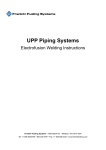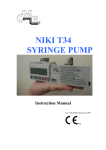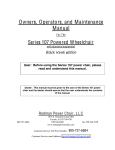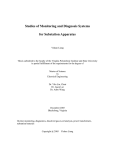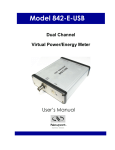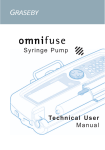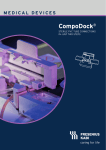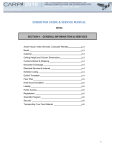Download Fresenius Pilote A2 - Frank`s Hospital Workshop
Transcript
OPERATOR’S GUIDE Syringe pump Introduction 3,/27$ Table of contents Operations for use ...................................................... 2 The Pilot A2 has been designed and manufactured with the greatest care. It introduces a new concept of control with easy reading of alarms and safety features. Internal safety features ............................................... 3 The configuration flexibility of the Pilot A2 provides overall improvement in the working conditions of medical teams, thus increasing patient safety. A choice of easily accessible configurations ensures optimum use of functions according to the needs of each department. Technical characteristics ........................................... 6 Performances............................................................... 5 Configuration ............................................................... 8 Operating precautions ................................................ 9 Maintenance............................................................... 10 External power source.............................................. 12 Operation with the internal battery.......................... 12 Accessories................................................................ 13 The use of this material requires great care. The user must be able to handle the instrument properly and must know how to fully operate. Please read the operator’s guide carefully before putting the device into use. Disposable ................................................................. 13 Conditions of guarantee ........................................... 14 Useful addresses....................................................... 16 Operations for use Infused volume Installation The syringe pump can be used on mains supply. , battery or external Particular attention should be paid to the stability of the device before it is put into use. Consulting the infused volume: Erasing the infused volume: (continuous press) 1. Connect the power supply cord to the mains source and to the syringe pump. The mains power indicator lights up . Note: connect device to mains as often as possible to recharge battery. Volume limit Programming a volume limit (ml): 10 Syringe installation 1 0.1 (double press) 1. Connect the extension set to the syringe according to proper practices. Programmed volume limit recall: (double press) 2. Place syringe in its cradle, the flanges correctly in the provided slot. 3. Turn the syringe barrel clasp into the closed position and move the syringe drive forward the syringe plunger head. Syringe barrel clasp Í Syringe flanges cradle Erasing programmed volume limit: (continuous press) Bolus function Administering a bolus (ml): EROX (continuous press) Changing bolus rate (ml/h): Syringe plunger head 4. Press the ON key (continuous press) to turn ON the Pilot. Note: if &WU/ is displayed, preventive maintenance should be considered. Press to continue. STOP and Pause Programming infusion 1. Stop (sound warning after one minute): capacity brand and type Syringe brand selection: To resume infusion: 10 ml syringe list given as an example Drug name selection: (according to device configuration: 3$U&) 2. Pause duration selection, from 1 min to 9 hrs 59 min: (double press) $GUH (e.g.: ADRENALIN) Prime the line: 3XU* Ending Pause and resuming infusion: (continuous nd press) 3. Connect infusion set to patient and check general installation. Occlusion alarm threshold setting 4. Flowrate setting (ml/h): 3 occlusion pressure limits available. Selection is adjusted manually by a safety located on the rear of the syringe drive. 10 1 0.1 (e.g.: flow rate 5.2 ml/h) 5. Starting the infusion: Important: flow rate may be programmed during infusion and must be confirmed within 15 seconds following the change. Proceed as described above to change the syringe. Lower limit Upper limit OFF To turn off the Pilot : -2- Middle limit (press for more than 2 seconds) NU PIL A2 TD IS - 1342 rev 3 – 09/12/03 Internal safety features The Pilot device have a continuous inspection system which functions as soon as the pump is in use. Nevertheless, the qualified personnel in your establishment or our After-Sales Department should always be notified of any abnormal function where no specific cause can be found. In case of single fault condition, an alarm is activated within the limit of 5% rate deviation. In addition, a secondary control feature activates an alarm at 1 ml over infusion or 20% rate deviation, whichever is shortest. Note: the battery automatically takes over when the mains supply is disconnected. Prealarms and alarms With visual and audible signal. Checks Battery Infusion Stop Silence alarm Prealarm NO YES Alarm YES Activation Message low battery Battery alarm + prealarm indicators YES (2 min) discharged battery Battery alarm + alarm indicators Note: memorisation of programmed parameters (10 min). Connect device to mains. Mains Disconnection NO YES mains disconnected E$W messsage displayed. Press Infusion End of infusion prealarm NO YES 5 minutes before end of infusion alarm or 10% of total syringe capacity. to acknoledge this warning. Prealarm + end of infusion indicators Note: to use Empty syringe mode press CONFIRM key. End of infusion alarm YES YES Syringe empty (theory) Alarm + end of infusion indicators Note: to use Empty syringe mode press CONFIRM key. Volume limit Empty syringe YES YES Total syringe empty Prealarm NO YES 5 minutes before the volume limit alarm or 10% of syringe capacity. Alarm KVO rate Prealarm + end of infusion indicators Prealarm + flashing ml indicators YES (2 min) Volume limit reached Alarm + KVO + ml indicators Flashing alarm + Pressure Occlusion alarm YES YES (2 min) Programmed limit reached Syringe installed Syringe barrel clasp Syringe flanges insertion YES YES (2 min) Syringe incorrectly positioned Plunger head position Anti-siphon systems YES Disengaged mechanism YES occlusion indicators Alarm + syringe barrel clasp indicators YES Syringe incorrectly positioned Alarm + plunger head position indicators YES Drive systems not engaged Alarm + disengaged mechanism indicators Others alarms --- NO No confirm > 15 seconds No syringe selection YES YES no syringe selection > 1 min ● Flashing confirm signal + flashing capacity and brand syringe indicators Key disabled NO NO Pressing an unauthorised key Programmed end of pause YES NO Programmed end of pause Unconfirmed program or flow rate = 00.0 ml/hr NU PIL A2 TD IS - 1342 rev 3 – 09/12/03 ● Flashing confirm indicator Audible signal only Alternating displays of flow rate value and 6W23 -3- Checks Infusion Stop Silence alarm Activation Malfunction alarm YES YES Device cannot check the infusion Error message : (U YES YES Motor rotation control anomaly Message Technical malfunction + alarm indicators (U-- Error message + technical malfunction + alarm indicators Press STOP to resume the device normal operation Error messages : (U ; ; ; ; ; ; ; ; , YES YES Electronic control anomaly (U-Error message + technical malfunction + alarm indicators Error message : (U YES NO Keyboard anomaly (U-Error message + technical malfunction + alarm indicators Error messages : (U ; ; ; YES YES 1 ml deviation/ volume to be (U-Error message + technical infused malfunction + alarm indicators Preventive maintenance warning NO --- Date of maintenance reached (3$UE) &WU/ message only displayed when the device is turned on). Press CONFIRM to continue. Warning: check the device as soon as possible. Note: in case of malfunction alarm, note the error message ((U) and stop the device by pressing the OFF key (5 - 10 seconds can be necessary). If the alarm persists when the device is switched on again, without use on patient, contact the qualified technicians in your establishment or our AfterSales Department. The sound level can be set by rotating the shutter placed underneath the device -4- . NU PIL A2 TD IS - 1342 rev 3 – 09/12/03 Performances Display of the name of the drug Flow rates According to configuration (3$U&). The values given in the table below correspond to device configuration. It is possible to display periodically during infusion the name of the drug used. 15 names of drugs may be programmed by configuration (3$U*). Syringes 50/60 ml 20 ml Infusion flow rate (ml/h) from 0.1 to 200.0 from 0.1 to 120.0 Pressure limit Bolus rate (ml/h) from 50.0 to 500.0 from 50.0 to 275.0 Pilot A2 proposes a choice of 3 occlusion alarm thresholds. Prime rate (ml/h) 500.0 275.0 Syringes 0.1 ml/h increments. Volume limit from 1 to 99.9 ml, 0.1 ml increment Volume limit (ml) from 100 to 999 ml, 1 ml increment 50/60 ml 20 ml Threshold value lower z 300 600 (mmHg) middle zz 500 1000 upper zzz 900 1700 Values given for B-D Plastipak® Luer Lok® syringes. Note : 1 bar = 750 mmHg = 1000 hPa. KVO rate (Keep Vein Open): 1 ml/h or flow rate originally selected if this is less than 1 ml/h. Accuracy Flow rate accuracy ± 3 % with pre-programmed syringes Device accuracy ± 1% Syringe accuracy ± 2% Occlusion alarm response time versus infusion flow rate These values are representative of syringes used during trials with an Pilot A2 and serve as an indication only of the pump’s overall performance. Threshold values Pause duration Flow rate lower z middle zz upper Syringe 1 ml/h 40’ 60’ 120’ 50/60 ml 5 ml/h 8’ 12’ 20’ 120 ml/h 25’’ 35’’ 50’’ From 1 minute to 9 hours 59 minutes, 1 min. increments. Syringe type list The Pilot A2 recognises the size of the installed syringe. The last syringe brand used is proposed when the device is turned on. Brands and types B-D PLASTIPAK FRESENIUS INJECTOMAT BRAUN OMNIFIX BRAUN PERFUSOR PIC INDOLOR TERUMO 50/60 ml 20 ml Syringe used: B-D Plastipak® Luer Lok® (B-D Plastipak and Luer Lok are registered trademarks of Becton Dickinson). Bolus volume on occlusion release Different syringe lists are available. For further information, please contact our Customer Service. zzz Threshold value lower z middle zz upper zzz 50/60 ml syringe ≤ 0.2 ml ≤ 0.4 ml ≤ 0.8 ml 20 ml syringe ≤ 0.2 ml ≤ 0.4 ml ≤ 0.8 ml Note: wait until the Alarm + occlusion + flashing indicators turns on, indicating the bolus has been reduced. Fresenius Vial cannot accept any responsibility for errors in flow due to modifications of the specifications of the syringes introduced by the manufacturer. NU PIL A2 TD IS - 1342 rev 3 – 09/12/03 -5- Technical characteristics Mains supply Indicators lights Mains supply 230 V ~ - 50-60 Hz (110V on request) Maxi. consumption 100mA Maxi. power consumption 23 VA Internal protective fuse T 100 mA 250V IEC 127 External supply External supply 12 to 15 Volts - Continuous voltage Power > 15 Watts Mains power operation constant yellow Battery power operation constant green Confirm signal flashing green Infusion in progress flashing green Prealarm flashing orange Alarm flashing red KVO Battery Characteristics 6 V 1,1/1,3 Ah - Sealed lead rechargeable Autonomy min. 7 h av. at 5 ml/hr Battery recharging Partial (70% of capacity): 8 hours KVO flashing red ml constant or flashing green Flow rate ml/h constant or flashing green On hold duration min constant or flashing green Programmed volume limit or infused volume Total (100% of capacity): 16 hours Compliance Compliance with EN 60 601-1 and EN 60 601-2-24. CE0454 IP34 CE 0459 marking in compliance with EEC 93/42 Medical Device Directive Display 3 green digits (tens, units) 1 orange digit (decimals) Syringe list available (example) capacity (ml): constant or flashing green brand and type: constant or flashing green Occlusion flashing red Syringe barrel clasp flashing red Protection against ingress of liquid Protection against leakage current: Type CF equipment Protection against electrical shocks: Class II equipment Syringe flanges insertion Device materials Casing/ Drive/ Syringe barrel clasp Polycarbonate/ Polyester alloy / shock resistant Programming keyboard / labels Polyester Dimensions - Weight Height / Width / Depth 120 x 330 x 155 mm Weight approx. 2.2 Kg -6- Plunger head position anti- siphon system flashing red Disengaged mechanism flashing red End of infusion flashing orange Battery alarm flashing red Technical malfunction constant red NU PIL A2 TD IS - 1342 rev 3 – 09/12/03 Trumpet curves Trumpet curves demonstrate the evolution of the minimum and maximum variance of the Syringe/Syringe-Pump combination. The test protocol used to obtain these results is described in the EN 60 601-2-24. For further information, please refer to this publication. This graph is therefore representative of syringes used during trials and serve as an indication only of the pump’s overall performance. Please contact our After-Sales Department for the others curves. Syringes used B-D Plastipak® 50 ml Luer Lok®. NU PIL A2 TD IS - 1342 rev 3 – 09/12/03 -7- Configuration Fresenius Vial recommends the presence of its qualified personnel or of a member of the Technical Department of your establishment to help you implement the configuration procedures you wish to choose. Moving to configuration of the various parameters mode, press , then simultaneously : 3DU appears on display. Press + within 2 seconds to confirm start of configuration. Note: press Press to cancel modification at any time - Press Configuration mode Confirm Choice to leave configuration mode at any time. Configuration available on start up 3$U: flow rate memorizing last selection in ml/hr 3$U: syringe selection type automatic confirmation 3$U: max. flow rate selectable for 50 ml syringe types default value 00.0 ml/hr Display Press to select Confirm 0(0 QR0( manual scrolling 6(/ 6(/ for 20 ml syringe types FF max. flow rate FF 3$U: selectable syringes 1st syringe brand 50 ml capacity selectable 6(/ not selectable QR6( syringe list given as an example selection for all syringe list 3$U: confirming compulsory priming compulsory 3$U: KVO rate KVO rate 3$U$: empty syringe mode empty syringe mode 3$UE: frequency of maintenance from 1 to 9999 hours of continuous use ex : 1230 h 3$U&: drug name drug name selection GU8* 3$UG: syringe flanges syringe flanges detection 3$U): bolus rate memorizing last selection in ml/h 3$U*: drug name entry prime (after syringe confirming) priming not compulsory 3XU* QR3X .92 no KVO rate QR.9 no empty syringe mode no selection 68,G QR68 from 1 to 9999 QRGU no detection $,/( QR$, default value in ml/h 0(0 QR0( st 1 name of drug (15 names programmable) th Note: confirm the 15 name to leave 3$U* configuration. -8- 3$U-: mains disconnected detection disconnection detection 3$U2: date and time selection Date (G / 0 / \) and time (K / Q) selection no detection $GUH e.g.: ADRENALIN, from 50 to maxi or free name to accede to the to next name, or change the name ($=) 6(&W QR6( G : day 0 : month \ : year K : hour Q : minute NU PIL A2 TD IS - 1342 rev 3 – 09/12/03 Operating precautions The symbol visible on the condensed instruction guide of the device, recommends this Operator Guide should be completely read, in accordance with the EN 60 601-1 Standard. Standard precaution should be taken to prevent contamination or injuries while discarding the associate disposable (e.g. syringes, extension sets, needles, etc.). Fresenius Vial will not be liable for any damages or claims, medical or otherwise, of any nature whatsoever, whether direct or consequential, caused by improper use of this device. The device is designed to infuse any medical substance that can be injected. The physiological effects of medicine can be influenced by the characteristics of the device and disposable syringe. Check that they are compatible with prescriptions, the characteristics of trumpet curves and occlusion alarm setting times in relation to the programmed flow rate. Special attention must be paid to the stability of the Pilot. Use the device in horizontal position, on a table or with the I.V. pole accessories. We recommend you partially or completely recharge the battery when you receive the device or in the case of prolonged storage so as to prevent all risk of premature discharge. The device must not be used in the presence of inflammable anaesthetic agents due to the risk of explosion. It should always be used away from all risk areas. The recommended temperature for normal use of the device is between +10° and +40°C. The device may only be connected to the mains with the power cord supplied by the manufacturer. Check that the supply voltage corresponds with the value indicated on the label placed underneath the device. Fuses should be replaced by equivalent parts. Refer to the part list of the technical manual for full specification. Do not exceed the permitted voltage whether the supply is from the mains, an external source or via the different external connections. DC adapter should not be used. Only external battery like vehicle battery can be attached to drive the pump from external power. Fresenius Vial recommend the used of the external power source cable for Pilot. To preserve the environment, remove the battery from the device prior to destruction or at the end of the device life and as during normal maintenance replacement, return it to a competent recycling organisation. Proceed in the same way for the device itself (electronic boards, plastics…). Avoid short circuit and excessive temperature. This device can be disturbed by a large electromagnetic fields, external electrical influences and electrostatic discharges above the limits stipulated by EN 60 601-1-2 and EN 60 601-2-24. It can also be disturbed by pressure or pressure variations, mechanical shocks, heat ignition sources, etc. If you wish to use the device in special conditions, please contact our After-Sales Department. Only use Luer Lock three-part syringes from the list of pre-programmed brands. If a syringe is used which does not correspond to the syringe list on the device, the specified precision level cannot be guaranteed. Use only sterile catheter extensions which can resist pressures of up to 2000 HPa. While in use, negative pressure variation may occur in the syringe, by the relative height from the device to the injection site or by combined infusion devices such as blood pump, alternative clamp, etc. When the device is placed higher than the injection site, please pay attention to correctly secure the syringe and manipulate the syringe only when the extension set is clamped or disconnected from patient side. High depression may create syringe siphoning. In this situation, you must check the integrity if the syringe used (possible leakage), and if necessary insert anti-siphon valves. Pressure variation may generate flow discontinuity mainly noticeable at low flow rates and depending of the infusion system characteristics such as friction force, stickiness, compliance of syringes and mechanical back lash. Anti-siphon valves will also eliminate any risk of free flow during syringe changes. An air leakage in a syringe with a line not equipped with an anti-siphon valve may generate an uncontrolled flow delivery. Do not use in conjunction with positive pressure infusion devices that could generate back pressure higher than 2 000 Hpa susceptible to damage infusion disposable and the device. Fresenius Vial recommends the use of one way valves or positive pressure infusion devices for multi-line infusions. If there is no one way valve on a gravity infusion line during a multi-line infusion, this will make it impossible to detect occlusions on the patient side, and could result in accumulation of the drug being infused in the gravity line, which could later be infused in an uncontrolled manner when the occlusion is released. Place the connection between the feeder line and the syringe-driver line as near to the start of the catheter as possible in order to minimise the dead space and consequently the impact of any change in flow rate on the feeder line. Do not use this assembly Preferred assembly Non-reflux valve Opening the pump or the battery cover must only be carried out by the qualified personnel in your establishment, and taking all the necessary technical precautions. Non-respect of these procedures is dangerous to the personnel and may damage the syringe pump. We recommend you follow the maintenance procedures defined in the technical maintenance manual. To obtain a copy of the technical maintenance manual, please contact our After-Sales Department or our Commercial Department specifying the identification number of the device. The use of unscrewable extension lines or syringes may result in spillage if infusions are carried out at high flow rates and/or high pressure. Infusion line set up must be done in accordance with local standard operating procedures and good clinical practice. Fresenius Vial recommends the use of the Luer Lock type infusion lines proposed in page 13. NU PIL A2 TD IS - 1342 rev 3 – 09/12/03 -9- Maintenance Cleaning and disinfection Servicing The Pilot is part of the patient’s immediate environment. It is advisable to clean and disinfect the device’s external surfaces on a daily basis in order to protect patient and staff. To ensure normal performance of the device, it is recommended to replace the internal battery each 3 years. This should be done by a qualified technician. Disconnect the device from its mains supply before starting to clean. The qualified technicians in your establishment or our After-Sales Service Do not place in an AUTOCLAVE nor IMMERSE the device. Do not let should be informed if the device is dropped or if any of malfunction occurs. liquids enter the device’s casing. In this case, the device must not be used. If the device is placed in a high contamination risk unit, it is advisable For further information concerning the pump servicing or its use, please to leave it in the room during aerial disinfection, after having contact our After-Sales Service or our Customer service. disinfected it with a moist cloth. Use a cloth soaked in DETERGENT-DISINFECTANT, previously diluted with water if required, to destroy micro-organisms. Avoid abrasive scrubbing which could scratch the casing. Do not rinse or wipe surfaces. Do not use: TRICHLOROETHYLENE-DICHLOROETHYLENE AMMONIA - AMMONIUM CHLORIDE - CHLORINE and AROMATIC HYDROCARBON - ETHYLENE DICHLORIDE-METHYLENE CHLORIDE - CETONE. These aggressive agents could damage the plastic parts and cause device malfunction. If the device has to be returned to our After-Sales Department, proceed to its cleaning and desinfection. Then , pack it very carefully, if possible in its original packaging, before sending it. Fresenius Vial is not liable for loss or damage to the device during transport to our After-Sales Department. Regular inspections Storage Note: the pump must be checked, serviced and repaired only by Fresenius Vial or by a qualified technician. Failure to comply with these maintenance procedures can damage the device and lead to a functional failure. Take care also with ALCOHOL BASED SPRAYS (20% - 40% alcohol). They lead to tarnishing of and small cracks in the plastic, and do not provide the necessary cleaning prior to disinfection. Using disinfecting applies by SPRAYS may be done, in accordance with the In order to check that the device is functioning optimally, regular manufacturer recommendations, from a distance of 30 cm of the inspections are recommended every 12 months. device, avoid the accumulation of the product in liquid form. A regular control check consists of various inspection operations listed in Please contact the appropriate service, handling suitable cleaning and the Technical manual. These control checks must be performed by an disinfection products, in your establishment for further details. experienced technician and are not covered by any contract or agreement provided by Fresenius Vial. The device should be stored in a dry, cool place. In case of prolonged storage, the battery should be disconnected via the battery access flap situated underneath the device. This should be done by a qualified technician. Storage temperature: -10°C + 60°C. Permissive relative humidity: maxi 85%, no condensation. - 10 - NU PIL A2 TD IS - 1342 rev 3 – 09/12/03 Quick check procedure - Pilot A2 This protocol allows a quick check of the pump functionality. Serial number (ID/N): ............................. Date: ..... / ..... / ..... Department: ........................ Name: ............................. 1. Check the state of the device : absence of impact marks and noises (turn upside down the device), presence of all labels as well as their legibility. 2. Press ON (power supply lead not connected): the indicator illuminates. 3. Check the condition of the power lead and connect the device to the mains source : the mains indicator illuminates. YES NO 4. Install a syringe. and Auto-control mode : press simultaneously on &75 1. Press keys. Indicator light test. to start the test. 2. Check the presence of all luminous indicators and press . YES NO 3. Select 2.$< (comply) ; QR (no comply) or &WU (return) by pressing &75 1. Press , and confirm . Alarms test. to start the test : $/$5 appears on display. 2. The DISENGAGED MECHANISM and ANTI-SIPHON indicators flash. Disengage pusher block: constant indicators light up. The confirm signal flashes: press . 3. The SYRINGE BARREL CLASP and +,*+ flash. Position the syringe barrel clasp on upper position: constant indicator and +,*+ . light up. The confirm signal flashes: press 4. The flashing display indicates &&. Turn the syringe barrel clasp into the closed position and check the detected capacity by the device. The confirm signal flashes: press . 5. The SYRINGE BARREL CLASP and /28 flash. Remove the syringe and position the syringe barrel clasp on lower position: constant indicator and /28 light up. The confirm signal flashes: press 6. Select 2.$< or &WU (return) by pressing &75 1. Press and confirm YES NO . . Pusher block advance test. to start the test. 2. Install a 50 or 20 ml syringe filled at 7 cc. and start the test : UXQ appears on displays. The end of the test is signalled by : message 2.$< and 3. Select syringe FF (volume infused) for 50 and 20 ml syringe (check the advance of syringe plunger: 5 cc ± 0.5 cc). 4. Select 2.$< ; QR or &WU (return) by pressing and confirm . 5. After the validation of 2.$<, the message (QG indicates the end of the auto control test. 6. Press YES NO to restart device on normal mode. Visa : NU PIL A2 TD IS - 1342 rev 3 – 09/12/03 All control result comply: YES NO - 11 - 12-15 V power source A socket positioned on the rear panel makes it possible to use a 1215 V 15 W supply in rescue vehicles. Operation from the external power can be recognised by the mains indicator . The battery automatically recharges. Operation with the internal battery The Pilot contains an internal battery which automatically takes over when the mains supply is disconnected and ensures normal function with no loss of the programmed data. When mains is disconnected, the E$W message is displayed and a warning signal is turned on. Press to acknowledge this warning. Operation from the battery can be recognised by the battery indicator . Recharging the battery To recharge battery, just connect the Pilot to a mains power supply. Recharging of the battery is visualised by the mains indicator . Battery life indicator While the pump is running on battery, battery life may be displayed. Battery life displayed takes care of the current flow rate. E$W K autonomy in h/min Note: use charging mode for a complete battery life indicator when device is turned off. Charging mode It includes total duration of charging battery when device is not used. 1. Remove syringe and press 2. Charging mode activation: . &+$U (continuous press) Note: to leave the charging mode, press - 12 - (continuous press) NU PIL A2 TD IS - 1342 rev 3 – 09/12/03 Accessories Disposable Fresenius Vial recommends the use of Pilot range accessories. SE 2400Y - 2 channel - Sterile catheter extension set in PVC. Transfix cat # 073416 Composed of transport handle (cat # 073419) and the multi-purpose clamp (cat # 073418), this system enables rapid fixation to a horizontal rail or vertical support, decreases loss of space and provides perfect stability. Injectomat Line PVC 150 cm – Extension line for infusion. Transport Handle cat # 073419 Injectomat Line PE 200 orange - Opaque extension line for infusion of light sensitive drugs or for drugs not compatible with PVC. Multi-purpose clamp - cat # 073418 SE 1500 AR - 1 channel - Sterile catheter extension set in PVC with Y connector equipped with one way valve. RS 232 cord Cat. # 073413 (9m/9f) Cat. # 073414 (9m/25) SE 1600 AR AS - 1 channel - Sterile catheter extension set in PVC with anti-siphon valve and Y connector equipped with one way valve. Battery supply cable cat # 073415 Note that the expiry date is written on the packaging (set can be used for 5 years from the manufacturing date also written on the peel-open pouch). Power Fix 2 - cat # : 073428. All sets are designed and controlled by Fresenius in order to guarantee the performances and the safety features of our pumps. The manufacturing is done by Fresenius (CE0123, CE0459) or by its qualified subcontractors (CE0123, CE0318) for and on behalf of Fresenius in exclusive distribution. The CE certificates are available on request. Power Fix 4 - cat # : 073429. 1 power cord only to connect 2 or 4 Pilot to mains. Power Fix 2 and 4 : includes mounting clamps for I.V. pole. CE marking - complies with EN 60-601.1. 230 V ~ - 50/60 Hz (110 V on request). Power Link - cat # : 073430. To connect a POWER FIX 2 to a POWER FIX 2 or 4 together. Installation with 2 POWER FIX 2, 1 POWER LINK ; 1 ROLLING STAND 180 (cat # 073070) NU PIL A2 TD IS - 1342 rev 3 – 09/12/03 - 13 - Conditions of guarantee Fresenius Vial guarantee that this product is free from defects in materials and workmanship (excluding batteries and accessories) for a period of one year from the date of invoice. If you comply to benefit from the materials and workmanship guarantee from our After-Sales Service or an agent authorised by Fresenius Vial, the following conditions must be respected: The device must have been used according to the instructions in this Operator’s Guide. The device must not have been damaged when in storage, at the time of repair, or show signs of improper handling. The device must not have been altered or repaired by non-qualified personnel. The serial number (ID/N°) must not have been altered, changed, or erased. In case of non-respect of these conditions, Fresenius Vial will prepare an estimate for repair covering the parts and labour required. Where return and repair of a device is necessary, please contact Fresenius Vial Customer or After-Sales Department. - 14 - NU PIL A2 TD IS - 1342 rev 3 – 09/12/03 Notes NU PIL A2 TD IS - 1342 rev 3 – 09/12/03 - 15 - Useful addresses All requests for information or documentation (technical files, tubing sets catalogue or brochures) must be sent to: CUSTOMER SERVICE - AFTER-SALES SERVICE: Fresenius Vial Le Grand Chemin F-38590 BREZINS (France) Tel: +33 (0)4 76 67 10 10 Fax: +33 (0)4 76 67 11 34 Consult our Web site www.fresenius-vial.fr This Operator’s Guide may contain inaccuracies or typographical errors. Modifications may thus be made and will be included in later editions. As standards and equipment change from time to time, the features shown and described in this document must be confirmed by our departments. This Operator’s Guide may not be reproduced in whole or in part without the written consent of Fresenius Vial. Fresenius Vial - siège social : Le Grand Chemin - F-38590 BREZINS (FRANCE).
















